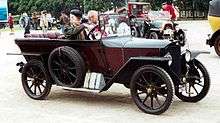AGA (automobile)

The Aktiengesellschaft für Automobilbau (= corporation for automotive engineering, abbreviation A.G.A. or AGA) was a German producer of cars in the 1920s in the German capital Berlin.
In 1909 in Berlin an AGA-company was founded as Autogen-Gas-Akkumulator-AG. It was the German filiation of the Swedish company Aktiebolaget Gas-Accumulator (AGA) which still exists in the 21st century since 2000 belonging to the German Linde AG. Since 1917 AGA in Berlin had a new factory-building in Berlin-Lichtenberg in Herzbergstraße. In WW I the company was producing parts for machine-guns. 1920 the Gas-company AGA was rebranded to Aktiengesellschaft für Automobilbau, but gas-AGA was founded newly at the same time, so that the Berlin Gas-company AGA existed parallel with the car-AGA. The gas-AGA was active even after 1945 in West-Berlin. Since 1922 the Berlin car-producer AGA was part of Stinnes-trust. Those data are based on the commercial register in the Berlin Landesarchiv.[1]
The first car, the Typ A of 1919 had a 1418 cc four-cylinder engine driving the rear wheels through a three speed manual transmission. The later Typ C followed in 1921 with the same configuration and engine gave a maximum of 20 PS (15 kW; 20 hp) as well as the later Typ A. This type had in the very beginning 16 PS (12 kW; 16 hp).[2] The car was without much obvious technical ambition, but it was inexpensive for its size and robust, becoming popular especially with small business owners despite its dire brakes.[3] In several cities, including Berlin and Breslau, it was for some time a popular car for use as a taxi.[4]
After the death of Hugo Stinnes in 1924 AGA ran into cash flow difficulties which ended in bankruptcy at the end of 1925. His son Edmund had been trying to implement the very expensive assembly-line production at AGA's, but never finished this project. Typ C, extending the wheelbase from 2,550 mm (100 in) to 2,780 mm (109 in), increasing the power persuaded from the 1418 cc engine to 24 PS (18 kW; 24 hp), and even fitting four wheel brakes.[5] Only very few cars of that kind were built. Never realized was a Typ D.
There were also plans for a small 850cc car to be built under licence from Singer as well as for a 45 PS (33 kW; 44 hp) six-cylinder model, but these never reached the production stage. From 1926, production had been severely curtailed and it ended in 1929. By that time there must have been between 8,000 and 12,000 AGA cars produced.[6]
Willy Loge was one of the AGA-racers. For the Targa Florio 1924 AGA produced a little number of a TF 6/30 PS sports-racing version which had a 1490cc engine. AGA won many races and was entered in the 1926 German Grand Prix. Other racers also drove AGA cars.
The Swedish Thulin company made only some hundred AGA cars under licence of AGA in Berlin and with the label Thulin between 1920 and 1924.
References
- Kai-Uwe Merz: Der AGA-Wagen. Eine Automobil-Geschichte aus Berlin, Verlag Berlin Story (2011, September), ISBN 978-3-86368-006-0
- Kai-Uwe Merz: Das Automobil des Nobelpreisträgers. Archivalische Studien zur Berliner Autogen-Gasaccumulator Aktiengesellschaft (AGA), der Berliner Aktiengesellschaft für Automobilbau (AGA) und der Stockholmer Aktiebolaget Gas-Accumulator (AGA), in: Berlin in Geschichte und Gegenwart, Jahrbuch des Landesarchivs Berlin 2011, edited by Werner Breunig and Uwe Schaper, Gebr. Mann Verlag Berlin (2011), ISBN 978-3-7861-2652-2
- David Hawtin: An East German Refugee. Vintage Aga 6/20 PS, in: The Automobile, Vol. 8, No. 1, (March 1990)
- Oswald, Werner (2001). Deutsche Autos 1920-1945, Band (vol) 2 (in German). Motorbuch Verlag. ISBN 3-613-02170-6.
External links
| Wikimedia Commons has media related to AGA vehicles. |
- Homepage in German language www.agamobil.de